As we allied with the Turks, the French beat the sea
The great French revolution 1789 of the year was a turning point in the historical development of mankind, which at the end of the XVIII century caused a new aggravation of the military-political situation in Europe. All the ruling European dynasties came out against France. Their goal was the destruction of the French Republic and the restoration of the Bourbon monarchy in France. However, in the first half of 1792, the French troops launched an offensive and soon took the path of aggression themselves. In the spring of 1796, they invaded Northern Italy, fixing their eyes on the Ionian Islands.
The Greek inhabitants of the Ionian archipelago appealed to the Russian Emperor Paul I with a request to accept them under his patronage. However, Russia could not oppose the aspirations of the French. As a result, in 1797, the French occupied Fr. Corfu and other islands of the archipelago.
In the evolving circumstances, Paul I was inclined to join the anti-French coalition in their struggle to "save the thrones" and send his fleet to the Mediterranean. Having ascertained that Turkey has no aggressive intentions against Russia, the emperor began to take steps towards rapprochement with the Ottoman Porte for joint action against a common enemy.
Intensive preparations of the French army and military fleet in Toulon and the incoming information about their plans to land in Egypt, persuaded the Turkish leadership to accept the proposal of the Russian cabinet to create a defensive alliance and to send a squadron of the Black Sea Fleet to facilitate and strengthen Turkish forces.
The decision on the participation of the Russian naval forces in the coalition war was issued in the form of an imperial rescript from 25 in July 1798, addressed to the commander of the Black Sea Fleet, Vice Admiral FF. Ushakov. It spoke of the need to immediately go with the squadron to the Dardanelles area and in the case of receiving an order to follow "with the Turkish fleet against the French, even if it happened further than Constantinople".
The 12 August squadron of the Black Sea Fleet, which included six of its best battleships, seven frigates, three advises and, with 1700 planted on them, soldiers of the Sevastopol garrison under the general command of Ushakov, left Sevastopol and headed for the Bosphorus.
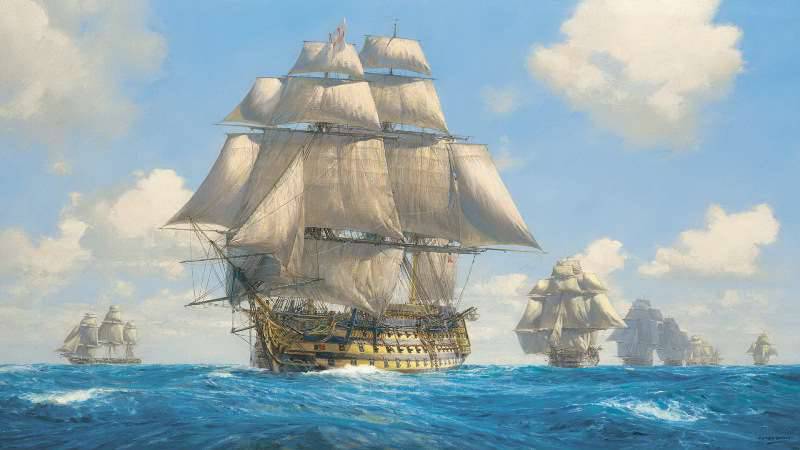
Thus, even before the official signing of the union treaty, Russia and Turkey decided to unite their fleets, as the most mobile forces, to oppose the army and navy of France. An important political precedent should be noted: the two powers, which had long-standing and sharp contradictions, decided to enter into a close military alliance, thereby confirming in practice the possibility of cooperation in the name of common interests in the region. Turkish Minister of Foreign Affairs (Reiz-Efendi) Atyf Ahmet noted: “One thing between thousands of misfortunes that the French revolution brought to light is, of course, the aversion of hostility and distrust between the two empires of Ports and Russia. For Porto, there is the most reliable protection, and integrity Ports are the most pressing business for the security of Russia. The characters of both sovereigns, the benefits of both nations bind us, and we have now explained our natural connection only. "
At noon 25 August 1798, the Russian squadron entered the Constantinople Canal and dropped anchor in Buyuk-Dere, opposite the house of the Russian envoy. The Turks greeted the Russian ships in a friendly manner, as Ushakov informed in his report of Paul I.
With the arrival of the Russian squadron in Constantinople, negotiations began with the participation of Turkish, Russian and English plenipotentiaries on the joint actions of the three powers against the French. At the 28 and 30 conferences in August 1798, a plan of military operations was drawn up for the naval forces of the coalition in the Mediterranean, according to which the Russian-Turkish squadron was to release the Ionian islands from the French in order to seize the strategic point in the Mediterranean - Fr. Corfu - and thus secure the Balkan possessions of the Turks. Parts of the squadron were ordered to follow to Rhodes, and then to the shores of Egypt, for action in conjunction with the English squadron of Commander Sydney Smith through the blockade of the Egyptian army of Bonaparte.
Another British squadron, commanded by Rear Admiral Nelson, was to block Malta, captured by the French 1 June along their route to Egypt. Thus, the essence of the developed plan was to destroy the French land and sea forces in the Ionian Islands and Malta, domination over which allowed the latter to control the situation in the central and northeastern part of the Mediterranean Sea, and also to block the Egyptian army of Bonaparte, left without sea cover and transport ships after the battle of Abukere (21-23 July 1798).
To implement the plan, the Russian squadron was combined with the Turkish, which consisted of four battleships, six frigates, four corvettes and fourteen gunboats. He commanded the Turkish squadron, Vice Admiral Kadir Bey. It is worth noting that the overall command of the combined Russian-Turkish squadron has not been determined. Each squadron submitted to its admiral. At the same time, the Turkish Sultan considered it necessary to indicate Kadir-bey "to read the Russian Vice-Admiral Yako Teacher", essentially defining the dominant position of Ushakov. This is not surprising if we recall how many times Ushakov "taught" the Turks.
Supply squadron laid on the Turkish side. As a result, the Russian-Turkish squadron included 10 battleships, 13 frigates, 7 small ships and 14 gunboats. In addition, in Sevastopol, prepared for the release of the next squad of two new 74-gun ships. On the British side, the Nelson squadron, which was located in Naples after the Battle of Abukir, was allocated to interact with the combined Russian-Turkish squadron.
The capture of the Ionian Islands was planned to be carried out by landing troops on them, gathered on the Albanian coast, Yanina and Morea. The total number of soldiers in the assault force, according to the sultan's command, was to reach 17 thousand. For the purpose of ideological training, Vice-Admiral Ushakov addressed the population of the islands seized by the French, and called for support of the coalition forces in the struggle for their release.
At the end of September 1798, the deployment of the allied squadron in the Mediterranean began. According to the agreement, four frigates and ten gunboats under the general command of A.A. Sorokin. But the main naval forces of the coalition went in three columns to the shores of the Seas.
The allied squadron in the Mediterranean was opposed by scattered French troops that concentrated on Corfu, Malta and Toulon as part of the 13 ships and 11 frigates. At the same time, most of them were unsuitable for conducting combat, Venetian and Maltese 64-gun ships. The main forces of the Franco-Spanish fleet were located in the ports of the Atlantic Ocean - Brest and Cadiz, the passage through the Strait of Gibraltar was closed by the squadron of Saint-Vincent.
The seizure of the Ionian Islands by the Russian-Turkish squadron was planned to be carried out sequentially, starting from the southeast, leaving no enemy strongholds in the rear that could interfere with the support of the squadron. To this end, it was decided to divide the combined squadron into several small detachments, which went to separate islands. The order of taking these islands was determined by orders of Vice Admiral Ushakov to the commanders of the detachments assigned to them from among the Russian officers.
The liberation of the Ionian Islands began on September 28 landing on about. Cerigo amphibious assault from the ships of the detachment under the command of I.A. Shostak. By November 1, after taking about. Santa Mavra, the French have already lost four of the seven islands. Success was achieved thanks to the attack of the combined squadron in order to capture coastal fortifications from sea directions.
Ahead clearly marked the main goal - the powerful fortress of Corfu, which was considered the key to the Adriatic. It was clear that it was not possible to take such a powerful fortress on the move, for that very considerable forces and thorough preparation were necessary. Therefore, Ushakov decides to organize the naval blockade of Corfu to prepare for the assault.
In the meantime, 23 of December 1798 of the year between Russia and Turkey was finally finalized an allied defense treaty, which served as the legal basis for the actions of the united squadron. Corfu's assault was followed in the morning of February 18 of the year 1799. As a result of a decisive attack that lasted no more than 12 hours, the bastions of Corfu were captured first from the sea and then from land. Storming the fortress of Corfu entered history as a model of a carefully thought out and logically completed naval operation. With this victory, Ushakov inscribed a bright page in the history of our fleet and made a notable contribution to the development of world naval art.
After the capture of Corfu in the hands of the Allies was the most important Mediterranean strategic point. Intensified national liberation movement in southern Italy. “This is news,” noted V. Musin-Pushkin-Bruce, the Russian envoy in Naples, in March to the name of Pavel I of Naples, “made important actions in Sicily. Almost all the provinces are armed and want to oppose the enemy. Cardinal Ruffo decided to go in Salerno. "
The conquest of Corfu completed the liberation of the Ionian Islands from the French and allowed the coalition forces to fully control the situation in the Mediterranean. The war entered a new phase in which the main hostilities were transferred to the land European theater. The fleet in the overall strategy was now seen as an auxiliary force, designed to assist the army in blockading the coast and naval bases of the enemy, as well as in the delivery of troops to combat sites.
During the period of the strategic deployment of allied forces in Europe, the Russian government, taking into account the requests of coalition partners, set the following tasks for the united squadron:
1. To assist the Neapolitan army in the liberation of the Kingdom of Both Sicily.
2. Block the port and fortress of Ancona.
3. To promote the cessation of enemy communications in the Adriatic Sea.
4. Contain a detachment of ships at about. Kandiya to strengthen, if necessary, the English squadron in Egypt.
5. Establish a new board in the Ionian Islands.
It should be noted that the establishment of the "new government" on the liberated Ionian Islands was not characteristic of the fleet. For the first time, this was entrusted not to diplomats, but to the squadron commander, which testified to the growing role and importance of the fleet in foreign policy, as well as to Ushakov’s world authority. Under the leadership of the Russian admiral on the Ionian Islands, the first national Greek state of the new time began to be created. With the direct participation of the Russian admiral, the constitution of the future republic was drafted and sent for approval to the Russian and Turkish monarchs.
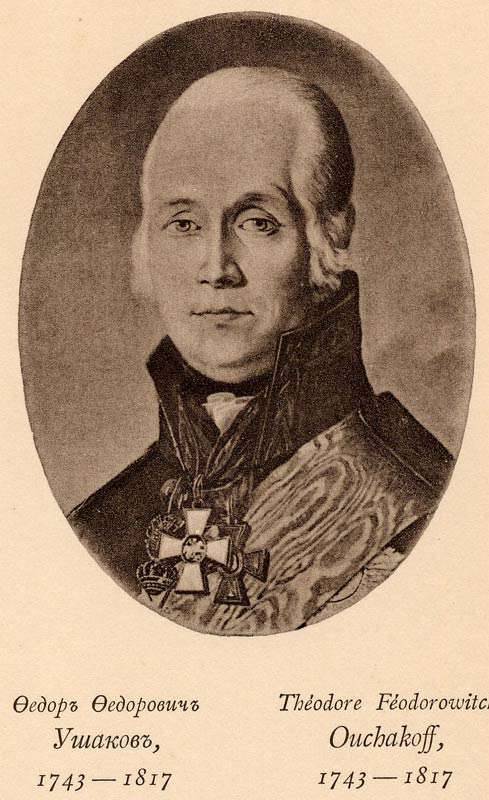
Contrary to the well-established view that the alleged unauthorized creation on the Ionian Islands of the republic Ushakov fell into disgrace, it should be noted that in fact his work was approved by Paul I. This was confirmed by his rescript from July 15, which stated: " Finding the measures mentioned by the admiral in Corfu, taken and presented by the Port, are consistent with our assumptions, we approve them. "
In April, 1799 began an offensive by coalition forces in Northern Italy under the command of Suvorov, who asked Ushakov to establish the naval blockade of Ancona (a port on the east coast of Italy), because through it French troops received reinforcements and violated communications of the allies in the Adriatic.
In response to a request, Ushakov undertook a maneuver by the forces of a united squadron. April 1 to Brindisi (port in southeastern Italy) for a joint action with Cardinal Ruffo’s militia sent a small detachment of four Russian frigates, a schooner, a Napolean frigate, four Turkish gunboats and a corvette with airborne forces commanded by Captain 2 of rank A .BUT. Sorokin. On April 23, a squadron consisting of three battleships, four frigates, three advises and a corvette, under the general command of Rear Admiral P.V., was sent for the blockade of Ancona. Pustoshkin.
In pursuance of the orders of Admiral Ushakov, a detachment of ships of the combined Russian-Turkish squadron of Captain Sorokin, sent to the Neapolitan provinces "to liberate the coast of Pulia from the French and to exterminate them from all the places with the coast located", in the second half of April went to the port of Brindisi, captured at the end of February by a French landing party landed from the Genére ship. The French garrison left a fortress when a small detachment appeared without resistance and left the small ships for Barletta. you, Sorokin decided, without stopping, to pursue the enemy along the coast in the direction of Marfedonia.
The raid of the united detachment along the Adriatic coast of Italy was characterized by high mobility and maneuverability. From April 30 to May 8, Sorokin managed to reach Marfedonia and take possession of it. Having landed troops in Marfedonia, Sorokin instructed him to command Lieutenant Commander Lieutenant Commander G.G. Belly, and sent deep into the territory to connect with the militia of Cardinal Ruffo, for a joint march on Naples. Belly's squad consisted of 510 men, among whom were 15 officers, 117 sailors, 312 non-commissioned officers and soldiers, 36 gunners with six guns and 30 people from a Neapolitan frigate. By June, he walked to the outskirts of Naples and camped 35 miles from the capital. Here he met with Ruffo.
In a short time, the assault force passed through the entire peninsula of the peninsula, smashing the remnants of the French troops and subordinating the king to the local population. Knight Mishuru, who was present during the detachment, enthusiastically wrote about this to Admiral Ushakov: "In just 20 days, a small Russian detachment returned to my state two thirds of the kingdom."
At the beginning of June, Belly’s detachment received reinforcements from Sorokin in the number of 95 men under the command of two officers. After joining with Cardinal Ruffo's militia, the detachment began preparations for the assault on Naples, in which up to 12 thousands of people from the French garrison and Neapolitan Jacobins were stationed.
3 June without preliminary artillery preparation, the troops, in the forefront of which was a detachment of Lieutenant Commander Belly, went to the assault. When the Allies captured Naples, the role of the Russian troop unit Belli was highlighted. "The Russian army corps," wrote Queen Maria-Carolina, "conquered the kingdom and capital."
Another squad, under the command of Pustoshkin, on May 5 approached Ancona and blocked a fortress garrison of two thousand men and three battleships in the port, a frigate, brigantine and more than twenty merchant ships and military transports. Pustoshkin was able to identify the defense system of the fortress and the port and to conclude that they could be captured while the squadron was reinforced by small landing ships and ground forces. He reported this to Admiral Ushakov and Field Marshal Suvorov, who approved his plan. As a result of the established cooperation between the Allied naval and land forces, by the end of May, reinforcements arrived to Ancona from Corfu: 270 Russian grenadiers, 21 naval gunner and 180 Turkish gallons (naval soldiers) under the command of Major A.Yu. Hamana The Austrian command, in coordination with Suvorov, for its part, sent a corps to Ancona, led by General Kleinau.
With the receipt of reinforcements, Pustoshkin proceeded to organize the blockade of Ancona from the sea and land. Based on the experience of taking the Ionian Islands, he called on the local population to assist the Allied squadron in exile of the French, after which it landed troops in the area of the town of Pesaro. Freeing it, the landing party quickly approached Ancona and drove the French out of the fortifications of Fano and Senegal. Fano was put in practically without a fight, and Senegal 6 June had to be taken by storm. As a result, the enemy retreated to Ancona, leaving the killed people on the battlefield before 30. Major Gaman’s troops lost three dead and 15 wounded.
Pustoshkin’s squad fully mastered the initiative, and the chances of success were quite high. However, given the request of Rear Admiral Nelson to help the Russian-Turkish squadron to confront the powerful French-Spanish fleet in the Mediterranean, Ushakov ordered Pustoshkin to return to Corfu immediately.
With the departure of the combined naval forces, the French in a short time re-seized Fano and Senegal. But the need to continue the blockade of Ancon made Admiral Ushakov 24 June send there a new detachment under the command of captain 2 of the rank ND. Voinovich, consisting of three Russian and one Turkish frigates, brigantines, a Turkish corvette and a small warship. Upon arrival at Ancona, the detachment defeated the enemy, captured the fortress of Fano and captured the 553 man. Together with the rebels, the detachment took the siege and Ancona itself.
At the same time, the Allied forces led by Suvorov were advancing in Northern Italy. By the end of June, all of Italy, except for the narrow strip of the Genoa Riviera and several fortresses, was in the hands of the Allies. Suvorov drew up a plan for further offensive on the Riviera and the advance of troops along the Ligurian coast through Lyon to Paris.
The successes of the allied army in Northern Italy and the combined squadron in the area of the Ionian Islands and southern Italy assured the Austrians and the British of the impossibility of the French army to regain lost ground in these areas. Therefore, taking into account their interests, Britain and Austria behind Russia’s back decided to change the overall strategic plan for waging war. Its essence was to withdraw the Russian troops from Italy to Switzerland, to land the Anglo-Russian troops in Holland, to clear the central Europe from the French, and then with joint efforts to attack France.
In late May - early June 1799, this plan was approved by the British monarch and communicated through Knight Marton to Austrian Foreign Minister Baron Tugut, after which the Viennese court gave his consent. Thus, at a time when Alexander Suvorov was planning to attack the Genoese Riviera, behind his back a plan was drawn up for the withdrawal of Russian troops to Switzerland.
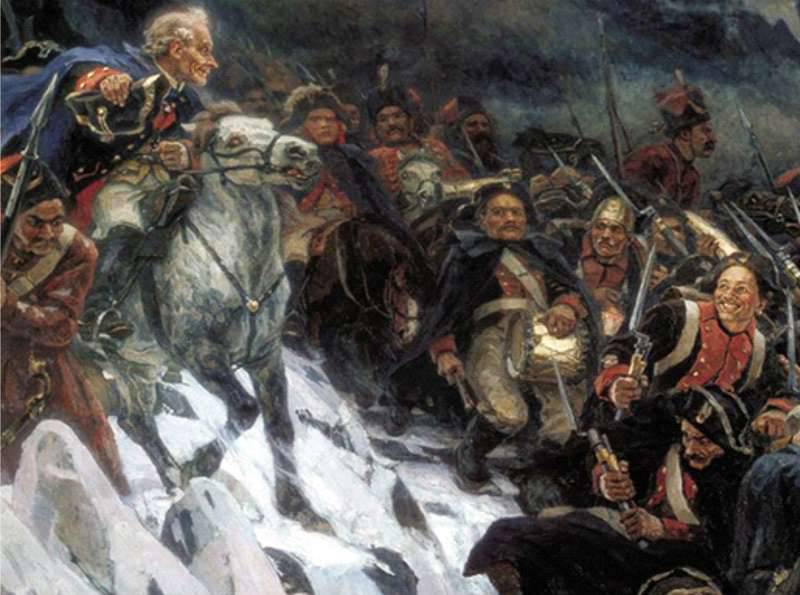
The contradictions that arose between the allies noticeably weakened the coalition and engendered mistrust between its participants. As Admiral Ushakov noted, "the British only cunning ... and before they did only one insanity ... They try to distract everyone from their activities, they are not able to manage in their enterprises ..."
The situation became much more complicated with the advent of the superior French-Spanish fleet in the Mediterranean. Nelson, in an interview with a Russian diplomat, Akim Lizakevich, admitted that he himself could not resist him and therefore requested assistance from Ushakov. On July 24, going towards Nelson, left Corfu with a squadron consisting of six Russian ships, three frigates, four advises, and four Turkish ships, three frigates, one corvette and a kirlangich, having on board 3 thousands of people from Albanian troops, and 3 August approached Messina. On the same day, a detachment of Russian ships, Vice Admiral PK, came from Portsmouth to Palermo. Kartseva.
On the day of arrival, Ushakov received a letter from Suvorov announcing the need for a blockade of the coast of Genoa, to which the French army of General Moreau had departed, after an unsuccessful attempt to unite with the troops of General MacDonald. According to Suvorov, their positions in a town near Savona and in the Gulf of Vado represented a significant obstacle to their capture without the help of squadrons.
However, the three ships allocated by Nelson, a frigate and two fighters did not cope with the task. Therefore, on the same day, Ushakov sent a detachment consisting of two ships and two advises under the command of Pustoshkin to Genoa, and sent a Sorokin detachment of three frigates to Naples. Performing an independent task, Pustoshkin close blockade of the Genoese coast and active actions on communications caused significant damage to the enemy. With the arrival of 21 August combined squadron in Palermo, it turned out that the enemy fleet had already left the Mediterranean. There was only one task before the Allied fleet - the capture of Malta, where, since September 1798, the four thousand French garrison was in blockade, with three ships and the same number of frigates.
An important point in the history of the interaction of the allied fleets of Russia, Turkey and England was the meeting held on August 24. The advantage of the Russian admiral’s approaches to the capture of coastal fortresses was demonstrated. So if Nelson's position was that the bastions of Fr. Malta cannot be attacked by ships and embark on their assault without a large landing force, Ushakov firmly held the view that it was necessary to take a fortress by storm or, at least, “frighten” the enemy.
In Naples, Ushakov formed a detachment of naval troops from 800 people with a Neapolitan regular army attached to him from 1500 people, September 19 sent him to take Rome. However, Nelson, behind Ushakov, also sent the battleship Minotaur to Rome under the command of Trubridge, who, approaching Civitavecchia, offered French General Garnier to surrender Civitavecchia and Rome for an honorable surrender and soon concluded it. Based on the signed surrender, the 1400 man of the French garrison and the local Jacobins left Rome. Nevertheless, the march of Russian sailors to Rome had to be continued in order to avoid plundering the city. The entry of the navy into Rome was, according to the memoirs of contemporaries, greeted with delight by the locals. By this time, dramatic changes had occurred in the theater of war. August 4 Suvorov defeated General Joubert’s 40 army in Novi. The Russian troops intended to attack the Genoese Riviera, but the British and Austrians insisted on their plan of hostilities, and on August 6 the Russian-Austrian troops, to the extraordinary surprise of the French, at the command of the Austrian emperor, stopped their pursuit and retreated to their original positions, which occupied before the battle. 28 August Suvorov with his troops went to Walesa, and then Switzerland.
With the departure of Suvorov from Italy, the French again launched an offensive in the area of Piedmont and the Genoese regions. September 14-15 Russian troops commanded by Lieutenant General A.M. Rimsky-Korsakov, were defeated at Zurich. Under these conditions, Pavel I decided to leave the coalition, in connection with which 8 of October was signed by him a decree on the return of Ushakov’s squadron to the Black Sea, and on October 11 of withdrawal of Suvorov’s troops from Europe. At the end of 1799, the squadron of Admiral Ushakov withdrew from Italy to Corfu. Since that time, the collapse of Russian forces in the Mediterranean began.
As a result of lengthy Russian-Turkish negotiations on March 21, the Constantinople Convention was concluded and a new constitution of the Republic of the seven united islands was approved, which legally fixed the results of the combat activities of the united Russian-Turkish squadron. Thus, for the first time in the new history, a national Greek state was created under the protectorate of Turkey and Russian patronage. The latter was able to maintain its naval presence on Corfu, which allowed it to occupy a strategically advantageous point in the Mediterranean and influence European affairs. This was one of the real results of our country's participation in the coalition war against France.
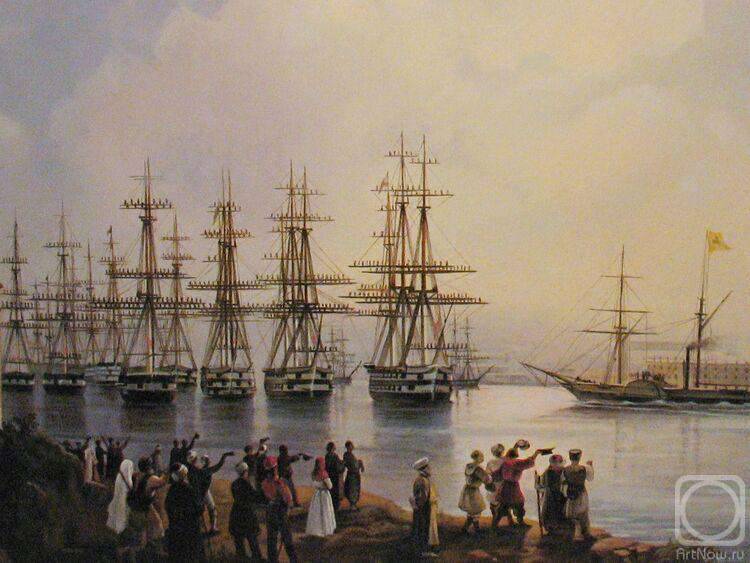
By the summer of 1800, the scattered forces of the Russian squadron were assembled in Corfu to prepare for their return to their homeland. July 6 squadron Ushakova left the Ionian Islands and October 26 came to Sevastopol. This was the end of the famous Mediterranean expedition.
Sources:
Ovchinnikov V. Admiral Ushakov and his time. M .: OLMA PRESS, 2003. C.309-321
Satsky A. Fedor Fedorovich Ushakov. // Questions of history. 2002. No. 3. C. 57-65.
Ovchinnikov V. Led the enemy into the weakest state. // Sea collection. 1995. No.8. C. 81-85.
Chernyshev A. The Russian fleet in the wars with Napoleonic France. M .: VETCHE, 2012. C.69-93
Ganichev V. Ushakov. M .: Young Guard, 1990. 321-344.
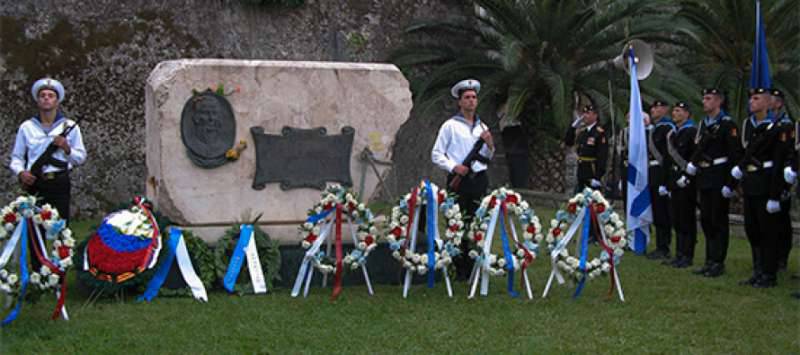
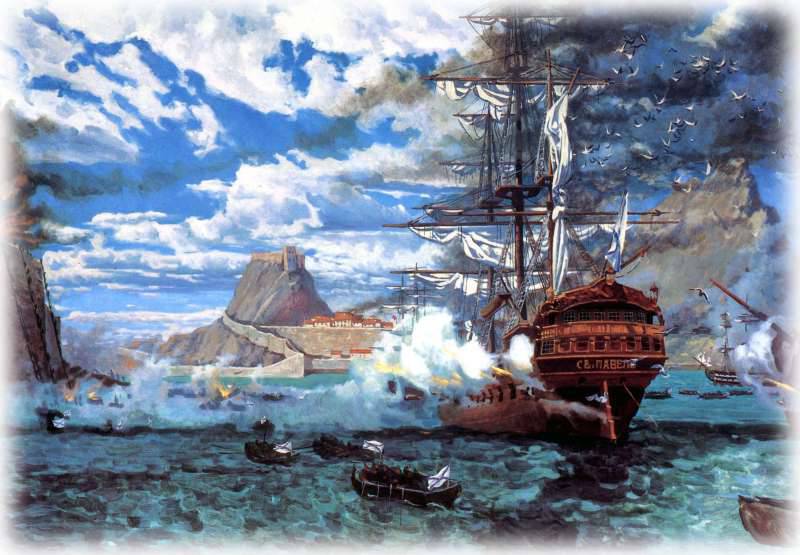
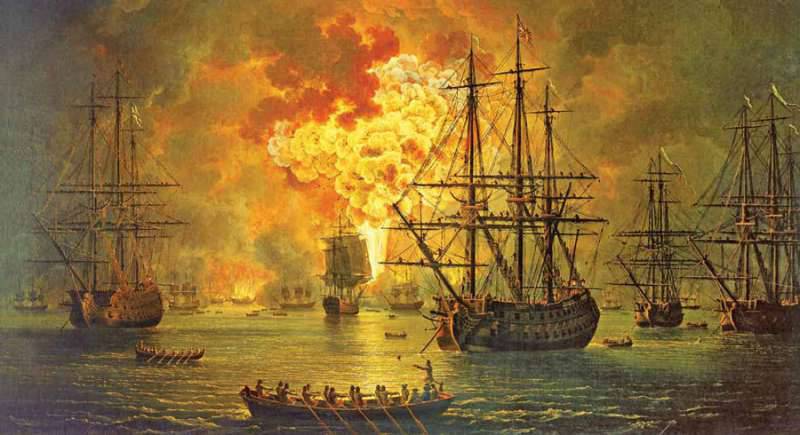
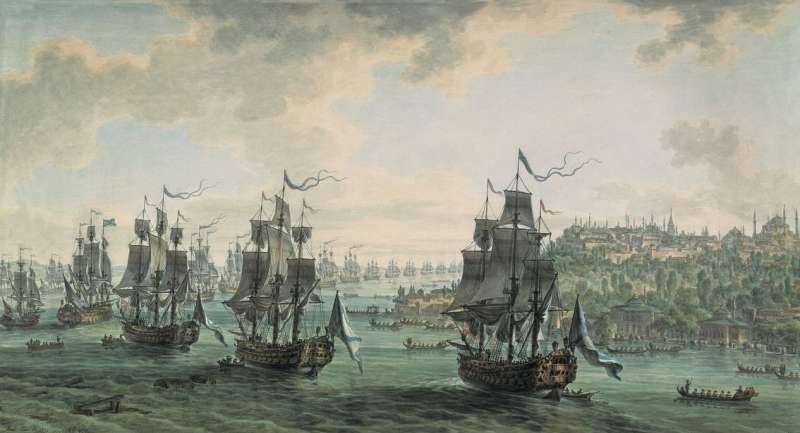
Information